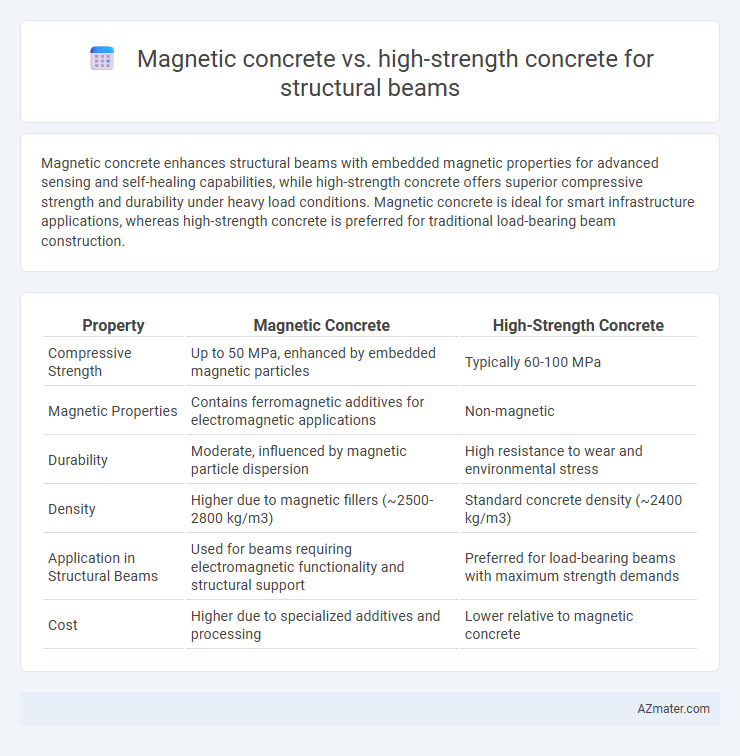Magnetic concrete enhances structural beams with embedded magnetic properties for advanced sensing and self-healing capabilities, while high-strength concrete offers superior compressive strength and durability under heavy load conditions. Magnetic concrete is ideal for smart infrastructure applications, whereas high-strength concrete is preferred for traditional load-bearing beam construction.
Table of Comparison
| Property | Magnetic Concrete | High-Strength Concrete |
|---|---|---|
| Compressive Strength | Up to 50 MPa, enhanced by embedded magnetic particles | Typically 60-100 MPa |
| Magnetic Properties | Contains ferromagnetic additives for electromagnetic applications | Non-magnetic |
| Durability | Moderate, influenced by magnetic particle dispersion | High resistance to wear and environmental stress |
| Density | Higher due to magnetic fillers (~2500-2800 kg/m3) | Standard concrete density (~2400 kg/m3) |
| Application in Structural Beams | Used for beams requiring electromagnetic functionality and structural support | Preferred for load-bearing beams with maximum strength demands |
| Cost | Higher due to specialized additives and processing | Lower relative to magnetic concrete |
Introduction to Magnetic Concrete and High-Strength Concrete
Magnetic concrete incorporates ferromagnetic materials such as iron oxide nanoparticles, enhancing electromagnetic properties while maintaining structural integrity, making it suitable for beams requiring both strength and functionality in smart infrastructure. High-strength concrete achieves compressive strengths typically above 40 MPa through optimized mixtures with low water-to-cement ratios and high-quality aggregates, providing superior load-bearing capacity for structural beams in demanding construction projects. Comparing both, magnetic concrete offers multifunctional advantages in sensing and durability, whereas high-strength concrete focuses primarily on maximizing mechanical performance in beam applications.
Composition and Material Properties
Magnetic concrete incorporates ferromagnetic materials such as iron particles or magnetite, enhancing its magnetic properties while maintaining structural integrity, whereas high-strength concrete typically emphasizes a lower water-cement ratio, high-quality aggregates, and supplementary cementitious materials like silica fume to maximize compressive strength often exceeding 70 MPa. The inclusion of magnetic components in magnetic concrete can influence its density and thermal conductivity, whereas high-strength concrete is optimized for mechanical performance including increased modulus of elasticity and reduced porosity. For structural beams, magnetic concrete offers multifunctionality with magnetic responsiveness, while high-strength concrete ensures superior load-bearing capacity and durability under mechanical stress.
Structural Applications of Magnetic Concrete
Magnetic concrete enhances structural beams by integrating ferromagnetic materials, improving load distribution and enabling active vibration control crucial for seismic resistance. This innovative composite offers superior ductility and electromagnetic shielding compared to traditional high-strength concrete, which predominantly emphasizes compressive strength and durability. Structural applications of magnetic concrete include adaptive beam systems in bridges and high-rise buildings where dynamic response and electromagnetic interference mitigation are critical.
Structural Applications of High-Strength Concrete
High-strength concrete (HSC) exhibits superior compressive strength, making it ideal for structural beams requiring enhanced load-carrying capacity and reduced cross-sectional dimensions. Its dense microstructure improves durability and resistance to environmental stressors, ensuring longevity in critical infrastructure applications. Compared to magnetic concrete, HSC's optimized aggregate gradation and cementitious materials provide consistent performance, crucial for safety and reliability in structural frameworks.
Mechanical Performance and Durability
Magnetic concrete exhibits enhanced mechanical performance in structural beams due to its improved compressive strength and magnetic field-assisted crack resistance, outperforming standard high-strength concrete in load-bearing capacity. The incorporation of magnetite particles in magnetic concrete enhances durability by reducing microcrack propagation and increasing corrosion resistance, leading to longer service life under cyclic loading and aggressive environmental conditions. High-strength concrete offers superior compressive strength but may suffer from brittleness and reduced toughness compared to magnetic concrete, which balances strength with improved fracture toughness and durability.
Load-Bearing Capacity Comparison
Magnetic concrete demonstrates enhanced load-bearing capacity compared to high-strength concrete due to the incorporation of ferromagnetic particles that improve stress distribution and crack resistance within structural beams. Studies indicate that magnetic concrete beams can sustain up to 15-20% higher loads before failure, attributed to their unique magnetic reinforcement mechanisms that enhance toughness and durability. High-strength concrete offers superior compressive strength but lacks the multifunctional reinforcement properties that contribute to the improved mechanical performance observed in magnetic concrete beams.
Sustainability and Environmental Impact
Magnetic concrete incorporates magnetically responsive materials, enhancing durability and enabling self-sensing capabilities, which extends the service life of structural beams and reduces the need for frequent replacements, thus lowering environmental impact. High-strength concrete achieves superior load-bearing capacity with reduced material volume, minimizing resource consumption and carbon footprint during construction. Both materials contribute to sustainable building practices by improving structural longevity and optimizing raw material usage, but magnetic concrete offers potential advancements in real-time monitoring that can lead to more efficient maintenance and further environmental benefits.
Construction Techniques and Challenges
Magnetic concrete requires specialized mixing processes to uniformly distribute ferromagnetic particles, complicating traditional casting and curing methods used in high-strength concrete. High-strength concrete leverages optimized aggregate gradation and admixtures like superplasticizers to achieve greater compressive strength, facilitating faster formwork removal and loading. Challenges with magnetic concrete include ensuring consistent magnetic properties without compromising structural integrity, whereas high-strength concrete demands precise control of water-cement ratio and curing conditions to prevent brittleness and cracking.
Cost Analysis and Economic Considerations
Magnetic concrete typically incurs higher initial costs due to specialized materials and manufacturing processes compared to high-strength concrete, which benefits from widespread availability and established production techniques. Long-term economic considerations favor high-strength concrete for structural beams since it requires less maintenance and offers predictable performance under load conditions. Cost analysis reveals that while magnetic concrete can provide innovative functionalities, its premium price and uncertain lifecycle savings make high-strength concrete more economically viable for most construction projects.
Conclusion: Choosing the Right Concrete for Structural Beams
Magnetic concrete offers unique electromagnetic interference shielding and corrosion resistance benefits, making it suitable for specialized structural beam applications in infrastructure exposed to electromagnetic fields. High-strength concrete provides superior compressive strength and durability, ensuring optimal load-bearing capacity and long-term performance in conventional structural designs. Selecting the right concrete depends on specific project requirements, with high-strength concrete favored for general structural beams and magnetic concrete chosen for beams needing added electromagnetic and corrosion protection.

Infographic: Magnetic concrete vs High-strength concrete for Structural beam
 azmater.com
azmater.com